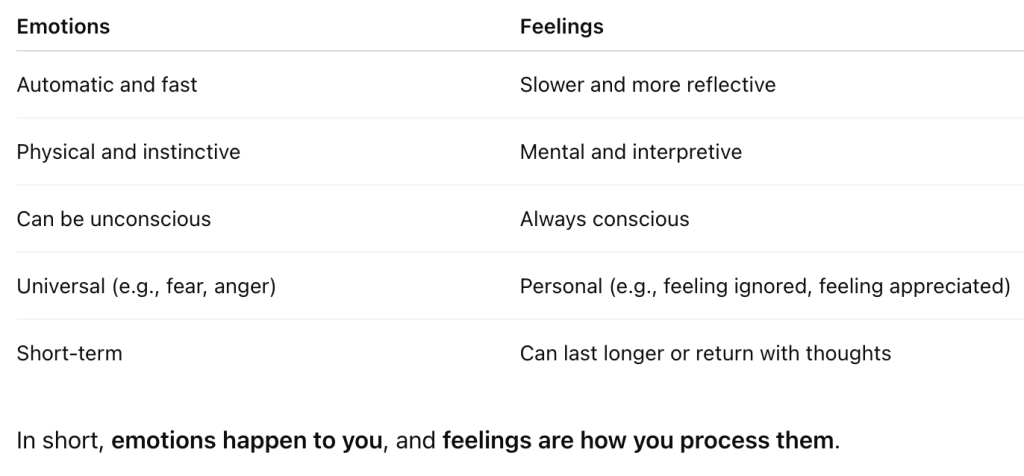We often use the words “feelings” and “emotions” as if they mean the same thing. In everyday conversation, saying “I feel sad” or “I have an emotion of sadness” might seem interchangeable. But in psychology, there is a subtle yet meaningful difference between the two. Understanding this difference can help us become more self-aware and better at managing our emotional experiences.
What are emotions?
Emotions are complex reactions that happen automatically in response to a situation, thought, or memory. They are biological and instinctive, meaning they are part of how we are wired as humans. Emotions often arise before we are fully conscious of what we are feeling.
When you’re in danger, your body may experience fear before your brain has time to analyze the situation. Your heart races, your breathing changes, and your muscles tense. This is your emotional system at work—responding to a potential threat to keep you safe.
Emotions involve several components:
- A trigger (something happens)
- A physical response (heartbeat, sweating, etc.)
- A mental evaluation (interpreting what’s happening)
- A tendency to act (like running from danger or seeking comfort)
Common examples of emotions include:
- Anger
- Joy
- Fear
- Sadness
- Surprise
- Disgust
These are often called primary emotions because they are universal across cultures and usually occur quickly and naturally.
What are feelings?
Feelings are the conscious experience of emotion. They are shaped not only by our emotional response but also by our thoughts, memories, beliefs, and personal experiences. Feelings tend to last longer than emotions and are often more influenced by how we interpret a situation.
For example, you might feel a sudden emotion of anger if someone cuts you off in traffic. But after a few minutes, you may experience a feeling of frustration or disappointment, especially if you interpret the situation as a sign that people are inconsiderate or that your day is going poorly.
Feelings are more personal and subjective. Two people can have the same emotion but experience different feelings depending on how they think about what happened.
Key differences between feelings and emotions
Although feelings and emotions are closely connected, they are not the same. Here are a few important differences:

Emotion = the broad, instinctive reaction (anger)
Feeling = the more detailed, interpreted experience (frustration, resentment, irritation)
Why the distinction matters
Understanding the difference between emotions and feelings can help you better regulate your internal experiences. If you recognize that an emotion is simply a reaction, you don’t have to be controlled by it. You can pause, reflect, and choose how to respond. For example:
If you feel angry, recognizing it as an emotion helps you stop before saying something hurtful.
If you feel anxious, noticing your physical symptoms might help you take a deep breath before letting your thoughts spiral.
This awareness is a core part of emotional intelligence—the ability to recognize, understand, and manage emotions in yourself and others.
Examples
Here’s a breakdown to help clarify the relationship between emotions and feelings using clear examples. Think of emotions as the raw, automatic response, and feelings as the personal, interpreted experience that follows.
Anger (Emotion) has associated feelings:
- Frustration
- Resentment
- Irritation
- Bitterness
- Annoyance
These feelings may emerge depending on why the anger occurred and how the person thinks about it. For example, if someone feels repeatedly disrespected, anger might turn into resentment.
Fear (Emotion) has associated feelings:
- Anxiety
- Nervousness
- Insecurity
- Worry
- Dread
The raw emotion of fear might happen in a moment of threat, but ongoing worry or insecurity are feelings that arise when the fear continues in the mind.
Sadness (Emotion) has associated feelings:
- Loneliness
- Grief
- Disappointment
- Hopelessness
- Melancholy
Sadness might be the immediate emotion after a loss, while grief or hopelessness are deeper feelings that linger over time, shaped by thoughts and meaning.
Joy (Emotion) has associated feelings:
- Contentment
- Gratitude
- Satisfaction
- Delight
- Amusement
Joy can be a burst of emotion, like laughing at something funny, while contentment is a lasting feeling of being at peace.
Disgust (Emotion) has associated feelings:
- Disapproval
- Contempt
- Aversion
- Revulsion
- Moral outrage
Disgust is often automatic (like at a bad smell), while feelings like moral outrage may develop based on beliefs or values.
Surprise (Emotion) has associated feelings:
- Amazement
- Confusion
- Shock
- Wonder
- Curiosity
Surprise is the immediate emotional response to something unexpected; the feeling that follows depends on whether the surprise is pleasant or unpleasant.
Conclusion
Emotions and feelings are both essential parts of being human. Emotions are the body’s way of responding to the world quickly and automatically. Feelings, on the other hand, are shaped by our minds—by the meaning we assign to those emotional experiences.
When you can tell the difference between the two, you gain more control over your reactions. You can notice what you’re feeling, reflect on why it’s happening, and respond in a way that aligns with your values instead of reacting out of habit.
The next time you feel something strongly, try asking yourself: Is this an emotion I’m experiencing in the moment, or a feeling that’s connected to how I’m thinking about it? That simple question can help you live more mindfully and communicate with greater clarity.
